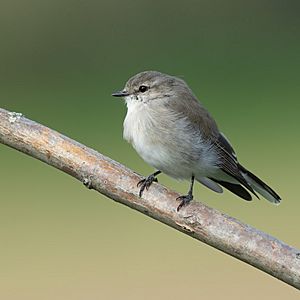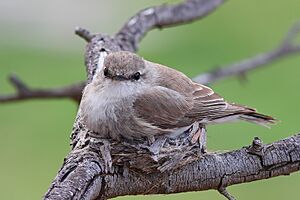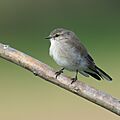Jacky winter facts for kids
Quick facts for kids Jacky winter |
|
|---|---|
 |
|
| Conservation status | |
| Scientific classification | |
| Genus: |
Microeca
|
| Species: |
fascinans
|
The jacky winter (Microeca fascinans) is a small, brownish-grey bird. You can find it commonly across Australia and also in Papua New Guinea. This bird got its name because of its quick, strong calls. They often sound like "jacky-jacky winter-winter" or "peter-peter-peter." Jacky winters like to live in open woodlands and on farmlands.
Contents
Jacky Winter's Family and Where It Lives
The jacky winter is part of a bird family called Petroicidae. This family includes about 49 different kinds of robins and flycatchers. All these birds live only in the Australasia region.
The name Microeca comes from ancient Greek words. Micros means 'small' and oikos means 'house'. This name refers to their very tiny nests. The second part of its scientific name, fascinans, is Latin for 'fascinating'. It comes from fascinare, meaning 'to bewitch'.
People also call the jacky winter by other names. These include brown flycatcher, peter peter, postboy, spinks, and stumpbird.
There are different types, or "races," of jacky winters.
- Microeca fascinans fascinans is common in eastern Australia. You can find it in central and eastern Queensland, New South Wales, Victoria, and southeastern South Australia.
- Microeca fascinans assimilis lives in South Australia and southern Western Australia.
- Microeca fascinans pallida is found in northern and western Queensland, the Northern Territory, and the Kimberley region of Western Australia.
- Microeca fascinans zimmeri is a type of jacky winter found in Papua New Guinea.
What Does a Jacky Winter Look Like?
The jacky winter is about 12 to 14 centimeters long. This includes its tail. It usually weighs between 14 and 18 grams.
The most common type, M. f. fascinans, has a greyish chest. Its lower half is white. Its head and back are greyish-brown. Its wings are a darker brown with white edges. It has a black beak and a thin line near its eye. Its tail is blackish-brown with white outer feathers. Its legs are black.
Another type, M. f. assimilis, looks very similar. However, it is darker. It has more grey on its chest and sides. This covers up some of the white seen on M. f. fascinans.
The M. f. pallida type is smaller. It is only about 13 centimeters long. It is also much paler in color. It often has a sandy brown look.
Jacky Winter Behaviour
Jacky winters often start singing before the sun rises. They usually stop singing around the middle of the day. Sometimes, you can hear them again closer to sunset. During the day, they like to sit on top of trees and posts. They might be preening their feathers to keep them clean. They also sun themselves to get rid of any tiny parasites in their feathers.
Jacky Winter's Diet
The jacky winter is an insectivore. This means it eats insects. It hunts by sitting and watching for food. It moves from one perch to another to find prey. This can be a continuous activity. They might travel long distances to find enough food.
Jacky winters use two main ways to hunt:
- Hawking: The bird flies up and then drops to the ground. It grabs its prey while still in flight.
- Ground-pouncing: The bird flies from a perch directly to the ground. It grabs its prey as it lands.
Both of these hunting styles are very common for the jacky winter.
Jacky Winter Reproduction
In many bird species, males have bright feathers to attract a mate. But jacky winters are different. Both the male and female look almost the same. This is called being sexually monomorphic. Instead of colorful feathers, the male jacky winter uses its song to attract a female.
In eastern Australia, jacky winters mostly breed west of the Great Dividing Range. They prefer areas with eucalyptus woodlands. They build a small, open, cup-shaped nest. Nests are often made from grass and strips of bark. They use spider webs to hold the nest together. The nest is usually built in an open spot, often in the fork of a branch.
The jacky winter breeding season is from September to November.
- In early September, males sing a lot.
- When the nestlings are born in late September, the singing becomes very quiet.
- In late October, singing increases again. This lasts until early November.
- Females then lay a second group of eggs, called a brood.
- By late November, when the young hatch, the males stop singing almost completely. This quiet period lasts until the birds leave the area.
The nesting period lasts about 15 to 20 days. The time it takes for eggs to hatch, called incubation, is between 16 and 18 days. Only the female bird will incubate the eggs. However, the male helps feed the young once they hatch. Most of the time, the female lays only two eggs at once. This number usually stays the same. It helps make sure the young birds have the best chance to survive.
Jacky winters defend their territory all year round. Their territory size is similar to other birds in their family. They prefer breeding spots with eucalyptus box woodland. They also like areas with fallen logs and stumps. They protect their territory by perching on eucalyptus trees and singing regularly.
Jacky Winter Status
The jacky winter is a common bird in Australia. The IUCN (a global group that studies nature) lists it as a species of Least Concern. This means it is not currently in danger of disappearing. However, like many other small woodland birds in Australia, the number of jacky winters is going down. They are still common, but their populations are decreasing.
All types of jacky winters in Australia are seeing fewer numbers:
- M. f. fascinans is decreasing in eastern Australia, including New South Wales, Queensland, and Victoria.
- M. f. assimilis is decreasing in Western Australia and parts of South Australia.
- M. f. pallida is decreasing in parts of Queensland, the Northern Territory, and the Kimberley in Western Australia.
Threats to Jacky Winters
Many woodland birds, including the jacky winter, are facing challenges. Their habitats are being broken up and damaged. This is happening in Australia and around the world.
Since Europeans settled in Australia, much of the woodlands have been turned into farms. This means land for crops or for animals to graze. Grazing animals hurt the jacky winter's habitat. They eat small plants and shrubs, leaving a lot of bare ground. This bare ground makes it harder for jacky winters to find the larger insects they eat.
More bare ground also means fewer places for jacky winters to build nests. Weeds can also grow more easily in these areas. This forces jacky winters to look for new homes. Finding good habitats is hard because other birds do well in these changed areas.
The noisy miner (Manorina melanocephala) is one bird that thrives in human-changed places. Noisy miners are very aggressive towards smaller insect-eating birds like the jacky winter. Jacky winters struggle to compete with noisy miners for food. Noisy miners also harm tree health. This limits the nesting materials available for jacky winters.
Climate change also threatens the jacky winter. A changing climate, caused by human activities, affects birds in many ways. It can change when they breed, when they migrate, and where they live. For jacky winters in Australia, rising temperatures and more evaporation are a concern. This leads to more droughts and bigger, more frequent fires. These changes are expected to reduce food availability. They also make it harder to find safe nesting sites and places to hide from predators. Rising temperatures have already caused birds worldwide to become smaller. This might be a way they are adapting to a warmer world. It also relates to less food and poorer habitat quality, which the jacky winter is experiencing.
Images for kids
See also
 In Spanish: Petroica fascinante para niños
In Spanish: Petroica fascinante para niños





